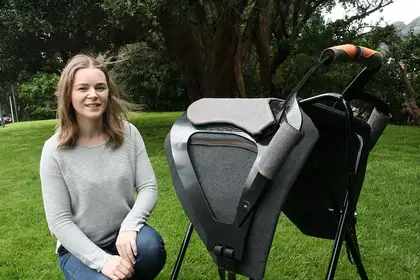
Industrial design graduate Holly Wright with her therapeutic equestrian saddle for disabled riders.
Industrial design graduate Holly Wright’s specialised saddle for disabled riders is creating excitement beyond equestrian circles.
The saddle, called Contak, focuses on safety, experience and adaptability for the rider, volunteers and the horse involved.
Next week her design will be honoured with a Best of the Best Award at the Red Dot Awards in Singapore and is nominated for a Designers Institute of New Zealand Best Award to be announced on Friday. Ms Wright graduated from the School of Design at Massey University’s College of Creative Arts earlier this year.
Working with Hutt Valley staff from the national charitable organisation Riding for the Disabled, she saw the opportunity to improve the assisted therapy experience for disabled riders and their volunteer walking helpers by analysing and rethinking the existing equipment.
Riders are accompanied by walkers on either side of the horse as well as a third person leading.
With multiple half-hour sessions in a day, walkers work with numerous riders with different needs requiring different equipment. There was an obvious need for simple, adaptable and effective equipment, Ms Wright says.
“My saddle design brings the rider 60 per cent closer to the horse which is important as the rider responds to the movement and gait of the horse. The further away from the horse they are it’s less stable and riskier.”
“Putting a rider on a horse gives the rider the feeling of walking without assistance and means they are effectively walking on the same plain as able-bodied people.”
The saddle features an elevated grasp handle for the rider that moves back and forward, adding to the therapeutic benefits of riding by engaging the muscles of the core.
The close contact and direct connection between horse and rider, allows heat transfer between the horse and rider resulting in positive physical therapy that relaxes and lengthens the large muscle groups in the rider’s legs.
“This is of immense benefit to children affected by cerebral palsy or other physical disabilities where the muscles are tightened or in spasm,” she says.
Her saddle design also provides a movable side grip to help when walking alongside the horse and relieves stress on the arm of the side walkers.
“The response was, ‘That’s going to save us a lot of pain’,” Ms Wright says.
It also potentially eliminates the need for one walker freeing them up to work with other clients at Riding for the Disabled.
Her design has been further enhanced with her choice to use a high-density polyethylene plastic, foam and felted wool, rather than wood and leather used in conventional saddle design.
“It will fit any shaped horse of any size because the shell material is so flexible,” she says.
“As an industrial designer, I am interested in the users experience of products; focusing on ergonomics, usability and functional aspects. I enjoy the research processes of design and seeing how this influences the design outcome.”
When she is not working on her latest design, Ms Wright is a keen rider herself competing in showjumping, eventing and dressage events, but before working with the organisation she knew very little about Riding for the Disabled.
“I’m interested in designing for good, products that help people,” the Wellington woman says expressing a wish to develop and market her product more with the charitable organisation.
“Having the opportunity to help people through Riding for the Disabled is amazing.”